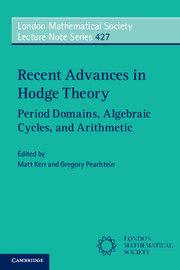Book contents
- Frontmatter
- Contents
- Preface
- Introduction
- List of Conference Participants
- Frontispiece
- PART I HODGE THEORY AT THE BOUNDARY
- PART II ALGEBRAIC CYCLES AND NORMAL FUNCTIONS
- 7 A simple construction of regulator indecomposable higher Chow cycles in elliptic surfaces
- 8 A relative version of the Beilinson-Hodge conjecture
- 9 Normal functions and spread of zero locus
- 10 Fields of definition of Hodge loci
- 11 Tate twists of Hodge structures arising from abelian varieties
- 12 Some surfaces of general type for which Bloch's conjecture holds
- PART III THE ARITHMETIC OF PERIODS
7 - A simple construction of regulator indecomposable higher Chow cycles in elliptic surfaces
from PART II - ALGEBRAIC CYCLES AND NORMAL FUNCTIONS
Published online by Cambridge University Press: 05 February 2016
- Frontmatter
- Contents
- Preface
- Introduction
- List of Conference Participants
- Frontispiece
- PART I HODGE THEORY AT THE BOUNDARY
- PART II ALGEBRAIC CYCLES AND NORMAL FUNCTIONS
- 7 A simple construction of regulator indecomposable higher Chow cycles in elliptic surfaces
- 8 A relative version of the Beilinson-Hodge conjecture
- 9 Normal functions and spread of zero locus
- 10 Fields of definition of Hodge loci
- 11 Tate twists of Hodge structures arising from abelian varieties
- 12 Some surfaces of general type for which Bloch's conjecture holds
- PART III THE ARITHMETIC OF PERIODS
Summary
Introduction
Let CHj(X, i) be Bloch's higher Chow groups of a projective smooth variety X over ℂ. A higher Chow cycle z ∈ CHj(X, i) is called indecomposable if it does not belong to the image of the map of the product
Of particular interest to us is CH2(X,1). For A = ℚ or ℝ, we say z ∈ CH2(X,1) A-regulator indecomposable if the regulator class reg(z) ∈ HD3(X,A(2)) in the Deligne-Beilinson cohomology group with coefficients in A does not belong to the image of HD1 (X,ℤ(1))⨂HD2 (X,A(1)) ≅ = ℂx⊗CH1(X)⊗A. In other words, z is A-regulator indecomposable if and only if
Obviously ℝ-reg. indecomp. ⇒ ℚ-reg. indecomp. ⇒ indecomposable.
Quite a lot of examples of ℚ or ℝ-regulator indecomposable cycles are obtained by many people ([1], [3], [4], [5], [6] and more).
In this note we construct R-regulator indecomposable cycles for X an elliptic surface which satisfies certain conditions. The main theorem is the following.
Theorem 1.1Let S be a smooth irreducible curve over ℂ. Let
be an elliptic fibration over S with a section s. This means that g and h are projective smooth morphisms of relative dimension 2 and 1 respectively, and the general fiber of f is an elliptic curve. For a point t ∈ S we denote Xt =g−1(t) or Ct= h−1 (t) the fibers over t. Assume that the following conditions hold.
(1) Let η be the generic point of S. Then there is a split multiplicative fiber Dη = f−1(P) ⊂ Xη of Kodaira type In, n ≥ 1 (see [8] VII, §5 for the terminology of “split multiplicative fiber”).
(2) Let D ⊂ X be the closure of Dη. Then there is a closed point 0 ∈ S(C) such that the specialization is multiplicative of type Im with m > n.
Then the composition
is non-zero for a general t ∈ S(ℂ). Here NF(Xt)⊂NS(Xt) denotes the subgroup generated by components of singular fibers and the section s(Ct).
- Type
- Chapter
- Information
- Recent Advances in Hodge TheoryPeriod Domains, Algebraic Cycles, and Arithmetic, pp. 231 - 240Publisher: Cambridge University PressPrint publication year: 2016



